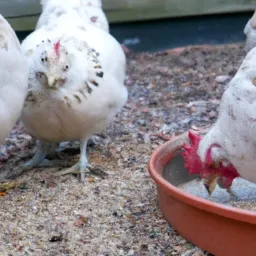The Ultimate Guide to Backyard Chicken Feeders
Welcome to the ultimate guide to backyard chicken feeders! Keeping a flock of chickens can be incredibly rewarding, but it also requires a lot of work and attention.
One important aspect of caring for your birds is ensuring that they have access to fresh food and water at all times.
Here, we’ll cover everything you need to know about choosing the right feeder for your flock, including different types of feeders, how many you need, and where to put them.
So… let’s get started!
Backyard Chicken Feeders
Backyard chicken feeders come in a variety of shapes and sizes, each with its own unique features and benefits.
The most common types of feeders are:
Hopper feeders: These feeders have a large capacity and are designed to dispense grain or pellets through an opening on top. They are ideal for larger flocks and can be hung from a tree branch or mounted on a pole.
Tube feeders: Also known as “bird seed” feeders, these feeders are made up of a series of small tubes that allow birds to peck out seeds one by one. They are great for smaller bird species like finches and sparrows.
Platform feeders: As the name suggests, platform feeders consist of a flat surface onto which birdseed is spread. They are popular among ground-feeding birds such as pigeons and doves.
Which Chicken Feeder is Best for Your Flock?
When it comes to choosing a feeder for your chickens, there are several factors to consider.
Firstly, think about the size of your flock – if you only have a few hens, a small hopper feeder may suffice, whereas larger flocks will require a bigger capacity feeder.
See also This Is Why You Use The Rat Proof Chicken Feeder
Secondly, consider the type of feed you plan to use – some feeders are better suited to certain types of feed than others.
For example, if you plan to use crumbles or mash, a hopper feeder would be a good choice.
Finally, think about the location of your coop and run – you want to make sure that the feeder is easily accessible to your birds without being too close to their roosting area.
How Many Feeders Do I Need for 6 Chickens?
The number of feeders you need depends on the size of your flock and the amount of space available in your coop and run.
Generally speaking, it’s best to provide multiple feeders so that your birds always have access to food. If you have six chickens, two feeders should suffice – one inside the coop and another outside in the run.
This will help prevent overcrowding around the feeder and ensure that everyone gets enough to eat.
Are Plastic or Metal Bird Feeders Better?
Both plastic and metal bird feeders have their advantages and disadvantages.
Plastic feeders tend to be more affordable and easier to clean, while metal feeders are generally more durable and longer lasting.
Ultimately, the decision between plastic and metal comes down to personal preference and budget.

Just make sure to choose a high-quality feeder regardless of the material, as poor-quality feeders can lead to wasted feed and an increased risk of disease.
Should I Put the Chicken Feeder in the Coop or Run?
It’s usually best to keep the feeder outside in the run rather than inside the coop.
See also Goohome Chicken Hutch Indoor Review
This helps prevent mess and waste within the coop and allows your birds to have easy access to food throughout the day.
Additionally, keeping the feeder outside reduces the risk of aggression towards dominant hens who might monopolize the feeder inside the coop.
However, if you live in an area with predators, it may be safer to keep the feeder inside the coop at night when your birds are roosting.
Automatic Chicken Feeders: Pros and Cons
Automatic chicken feeders offer convenience and reliability, allowing you to set it and forget it when it comes to feeding your flock.
Some automatic feeders even come equipped with technology that adjusts the amount of feed dispensed based on weather conditions and other variables.
However, automatic feeders can be expensive and may require additional maintenance or repairs.
And, some birds may become dependent on the automated system and lose their natural instinct to forage for food.
Choosing the right feeder for your backyard chickens takes careful consideration of various factors, including the size of your flock, the type of feed you plan to use, and the layout of your coop and run.
By following our tips and guidelines, you can select the perfect feeder for your birds and ensure that they stay healthy and well-fed.
